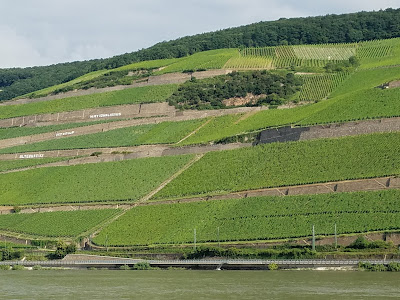We then cruised the scenic, castle-studded Rhine Gorge. In just 36 miles we pass a castle every few miles, each with its own history and legend.
From the beginning of history, the Rhine has been one of Europe's main north-south trade routes. Many of its castles were built by medieval robber barons to collect tolls on the passing barges.
Some castles were built to control and protect settlements, and others were residences of kings.
Most of the Rhine castles date from the 11th, 12th, and 13th centuries.
The Rhine Valley is storybook Germany--a fairy tale world of medieval castles, vine-covered hills, rugged cliffs, and half-timbered towns.
Loreley is a big cliff, rising 450 feet over the narrowest and deepest point of the Rhine. In medieval times, this was the most treacherous spot on the river.
Because of the Seven Maidens reefs just upstream and the sharp bend in the river, many ships crashed here.
Sailors blamed their misfortune on a beautiful maiden with long blonde hair who sang from atop the hill. Her siren-song distracted the sailors causing them to crash against the rocks.
As the ship passed the Seven Maidens reef, we saw the statue of Loreley on the shore, and then caught a glimpse of her running across our deck!
Our captain guided us through the treacherous area safely!!
Situated in the picturesque landscape of the Rhine and Mosel Rivers is the 2,000-year old town of Koblenz, Germany.
We stop here for the afternoon and take a guided city walk.
Koblenz has a abundance of cultural monuments and historic buildings. This city dates back to about 8 BC when the Romans built a fortification here to protect and control the land around the confluence of the 2 rivers--both important highways for trade.
Beneath the built-in clock tower (1724) you can see the "eye roller". It concerns the saga of the robber baron Johann Lutter von Kobern, who stole from the rich and the poor throughout the Rhineland.
He caused fear and alarm for years until he was caught in 1536 and sentenced to death by decapitation. On the way to his execution it is said that he spoke to the people. "Erect a memorial for me and it will bring you luck!"
At the gallows he rolled his eyes and stuck his tongue out at the spectators. This is the reason for the name eye roller. The eyes move back and forth in time with the clock's pendulum and every half hour and on the hour, he sticks his tongue out. It is said that Koblenz will have good fortune as long as the hideous face keeps watch over Johann Lutter and his story.
Terry wanted to sample a local beer while exploring Koblenz on our own.
Our next task was to find a pharmacy to replenish our cold medications, but it was Sunday and no pharmacies were open, so we continued with our siteseeing.
The Deutsche Eck, or German corner, is the tip of land where the Mosel and Rhine meet.
This piece of land is considered the heart of Germany. It is near and dear to German patriots, and has a reconstructed memorial to the Kaiser.
The monument contains three pieces of the original Berlin wall.
We then made our way back to our ship and that evening sailed away from Koblenz.
We have one more stop to make in Germany--Cologne. To continue reading, scroll up towards the top of this page and click in the right-hand column on the entry entitled: "Cologne, Germany".





































No comments:
Post a Comment